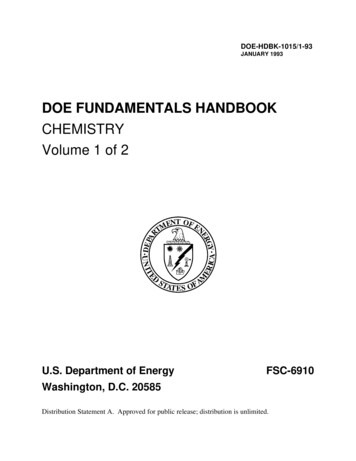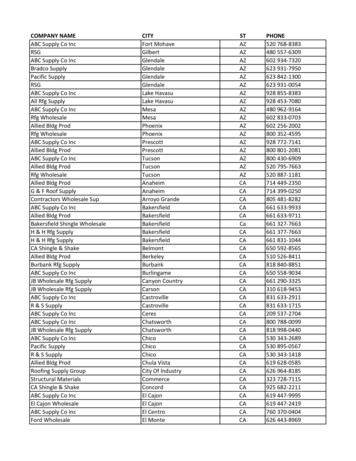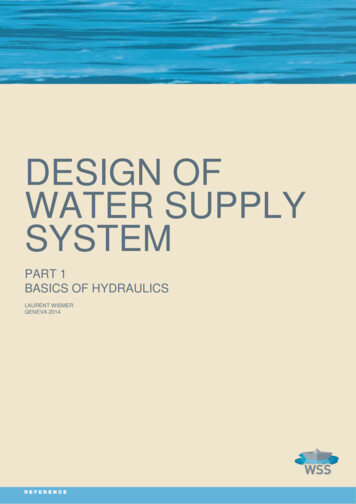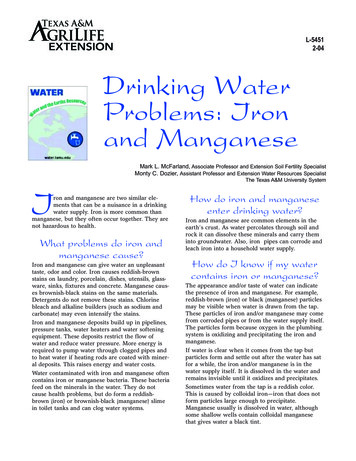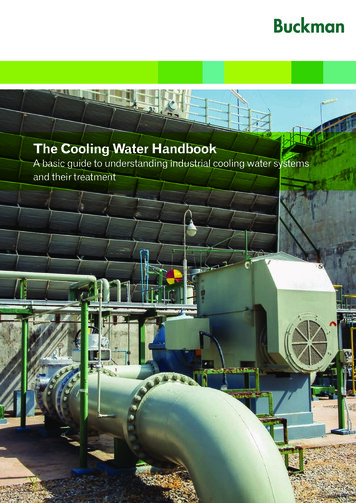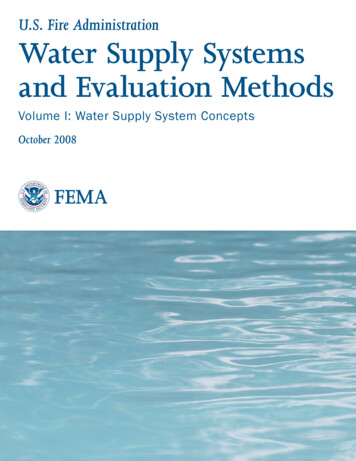
Transcription
U.S. Fire AdministrationWater Supply Systemsand Evaluation MethodsVolume I: Water Supply System ConceptsOctober 2008
U.S. Fire AdministrationMission StatementWe provide National leadership to foster a solid foundationfor local fire and emergency services for prevention,preparedness and response.
Water Supply SystemsandEvaluation Methods Volume I: Water Supply System Concepts Harry E. Hickey, Ph.D.
AcknowledgmentThis project was performed by the Society of Fire Protection Engineers (SFPE) and wassupported by the Department of Homeland Security’s Science and Technology Directorate andthe U.S. Fire Administration (USFA). SFPE is an engineering association for advancing the scienceand practice of fire protection engineering. Water supply is an important subject to the fire service,fire protection engineers, and city managers. These manuals are intended to provide a referencefor concepts and terminology to facilitate communication and understanding between theseorganizations.About the AuthorDr. Harry E. Hickey’s career in fire protection spans more than 50 years. He taught FireProtection Engineering at the University of Maryland for 26 years. He also has extensiveexperience in the fire services both as a firefighter, fire officer and Emergency Coordinator. Hiscombination of municipal fire administration and fire protection engineering experience provideshim with unique insight into the challenges of design and operation of municipal water supplies.He received his Ph.D. in Public Administration from American University in Washington, DC.He has authored many book and articles including Public Fire Safety, A Systems Approach, Fire ProtectionHydraulics, and two editions of The Fire Suppression Rating Schedule Handbook.
Table of ContentsChapter 1: Fundamental ConsiderationsTopic 1: Anatomy of a Water System.6Topic 2: Continuous Availability of Water Supply. 11Topic 3: Municipal Water Supply Considerations.13Topic 4: Water Sources.16Topic 5: Classification of Water Systems.19Chapter 2: Processed Water for Domestic Consumption.20Topic 1: Unfiltered Surface Water Sources.20Topic 2: Filtered Surface Water Sources.21Topic 3: Water Treatment Plants.23Topic 4: Auxiliary Facilities for Surface Water Treatment.28Topic 5: Ground Subsurface Water Systems.29Chapter 3: Water Quality Standards.32A General Perspective on Water Quality.32Water Quality Monitoring.39Chapter 4: Water Distribution System Design Concepts.51Water Supply Source Classifications.51Water System Components.52Water System Classifications.52Composite Water Supply Systems.56System Demand, Water Design and Flow Criteria.57Rates of Water Use.58Distribution System Appurtenances.58Hydrant Locations.66System Evaluation and Design.71 v
Water Supply Systems Vol. I: System Concepts Table of ContentsBasic Concepts in Determining Design Flow at System Demand Points.73Distribution System Storage.75Elevated and Ground Storage.77Comparison of System Examples.84Recommended Practice on Water Storage.84Chapter 5: Consumer Consumption and Needed Fire Flow.86Water Demands.86A Suitable Approach for Studying Consumer Use Water Demand.91Fire Suppression Water Demand.91Special Notes on the Determination of Needed Fire Flows.99Chapter 6: Alternative Water Supplies.101Alternative Water Supply Concepts.103Where are Alternative Water Supplies Needed.104Water Supply Officer.104Identifying and Certifying Alternative Water Supplies.105Establishing an Alternative Water Delivery Program. 112Chapter 7: Impacts of Fire Flow on Distribution System Water Quality, Design and Operation. 117Background Statement. 117Background. 118Study Objectives and Scope. 118Chapter 8: Dual Water Systems.138Basic Concepts.138Background Information.139Potential Applications for Dual Distribution Systems.139Sources of Nonpotable Water.141Potential Uses of Nonpotable Water.141Potential Uses for Nonpotable Water.141Nonpotable Water Reuse Legislation.143Reclaimed Water Quality and Treatment Requirements.145Reclaimed Water Monitoring Requirements.146Treatment Facility Reliability.147Groundwater Monitoring.147 vi
Water Supply Systems Vol. I: System Concepts Table of ContentsTreatment for Reclaimed Water.148Reclamation Plants.149Storage.150Features of Reclaimed Water Distribution Systems.151The Future Role of Dual Water Systems.152Chapter 9: Water Supply and Effective Fire Protection.153Overview.153The Insurance Services Office, Inc.153The Ability of Fire Departments to Provide Effective Fire Protection.154Fire Insurance Rates.155An Overview of Water Supply Under the ISO Fire Suppression Rating Schedule.155Insurance Company Assistance on Evaluating Water Supplies.158Advantages of Automatic Sprinkler Systems.159Water Supply Requirements for Sprinklered Properties.161Design Curves.161Hazard Classifications.163Residential Sprinkler Systems.163Types of Sprinklers for Commercial Buildings.164Pipe Schedule Systems.164Hydraulically Calculated Systems.164Standpipes.165The Physical Properties of Water.168Water Mist Fire Protection Systems.171Class A Foam Fire Protection.174Chapter 10: Separate Water Systems and Emergency Water Supplies.178Part I.178A Current Need for Individual Water Systems for Fire Protection.180Basic Design Concepts for Individual Water Supplies for Fire Protection.181Part II: Emergency Water Supplies.184 vii
Chapter 1: Fundamental ConsiderationsWater for human consumption comes from one of two basic sources:1) Water from a well to supply an individual residence, well water for farmstead properties, and wellwater for small public sector properties that include schools, public buildings, and small commercialenterprises.2) Municipal water systems that provide potable water to a wide array of commercial property anddomestic use buildings including apartments, condominiums, duplex housing, and single familydwellings.This chapter uses the Washington, DC, Water System as an example in order to introduce conceptsassociated with a fundamental understanding of water distribution systems. This system was selectedbecause it typifies many of the water systems in the United States that rely on water sources includingrivers, lakes, and low-level water retention dams. Other water supply sources are examined under Topic 3in this chapter.Understanding the fundamentals of a municipal water supply delivery system is essential to closelyexamining the many features of a water system and the many options in designing a water deliverysystem. Chapter 1 provides a basic overview of: The Anatomy of a Water SystemThe Need for a Continuously Available Water SupplyConsiderations for Establishing Municipal Water Supply SystemsClassification of Water Supply SourcesThe Classification of Water Supply SystemsTopic 1: Anatomy of a Water SystemThe purpose of municipal water delivery systems is to transport potable water from a water treatmentfacility to residential consumers, for use as drinking water, water for cooking, water for sanitaryconditions, and other water use in a domestic environment. Water supply also is essential for businessand industry to operate in a municipal environment. Of no less importance is the need to supply waterto properly located fire hydrants to provide the public with an effective level of fire protection. Municipalwater systems also may need to provide water for special services that include street cleaning, the selling ofwater to contractors for erecting buildings, parks and recreation, and miscellaneous uses. 1
Water Supply Systems Vol. I: System ConceptsChapter 1: Fundamental ConsiderationsA water system has two primary requirements: First, it needs to deliver adequate amounts of water tomeet consumer consumption requirements plus needed fire flow requirements. Second, the water systemneeds to be reliable; the required amount of water needs to be available 24 hours a day, 365 days a year.Anatomy may be defined as “separating or dividing a function into parts for detailed examination.” (1)A water supply system is analogous to the human circulatory system. The heart pumps blood throughthe arteries, veins, and capillaries to supply oxygen to all part of the body. A water pump supplies waterthrough primary, secondary, and distributor water mains to supply water to consumers and for fireprotection.This section examines the functional components of the water system by tracking the water from thesources that feed the municipal water system to the water tap. The term tap is used in a generic sense tomean any reference point on the water distribution piping where a connection or tap is made to supply alateral pipe to a domestic connection, a commercial connection, or a lateral line to a fire hydrant.Washington, DC, has a very old water system that has been updated in many ways. It serves as anexcellent example of a basic municipal water supply system. Variations to this system are reviewed laterin this manual.Every municipal water system has to have a water supply source that is both adequate and reliable for thecity to be served. The primary water source of water for Washington, DC, is the Potomac River. Withminor exceptions due to ice jams and flooding, this water supply has been reliable since before the CivilWar. Water is fed to the city from intakes at Great Falls and Little Falls both by a gravity aqueduct and by amore modern pumping station. The aqueduct water serves residents of the District of Columbia, ArlingtonCounty, Virginia, and Falls Church, Virginia.Figure 1-1 illustrates a progressive view of the water system. Two holding reservoirs supply water toa treatment plant that processes the water to remove impurities and adds chemicals to bring the waterinto compliance with the Environmental Protection Agency (EPA) regulations on clean water for drinkingand commercial cooking. The actual water treatment process is discussed. The purified water, or finishedwater, then is pumped to several different storage tanks and storage basins around the city for release intothe distribution system piping network on demand for consumer use or in the case of a working fire.Depending on the different elevations points throughout the city, additional pumping stations are providedto maintain adequate pressure in the water system during varying periods of consumer use or emergencywaster supply demand requirements. Water flows from the storage locations through the primary,secondary, and distributor mains to supply service lines to individual water consumers and lateral lines tosupply fire hydrants.This simplified illustration tracks raw water that originated at the Potomac River through the treatmentplant, the storage of water, and the movement of water through different sizes of water mains to serviceoutlets throughout the city to supply consumer demands. At the same time, water in the street mains ismaintained at adequate pressure to supply fire department pumpers that may need to take water from firehydrant to suppress structural fires and handle other emergency situations.Figure 1-2 illustrates eight basic steps that are used to produce a supply of potable water. These specificsteps are associated with the treatment plant for the city of Washington, DC, and fit into the treatmentfacility portion of Figure 1-1. While this is a generally acceptable method of purifying water, it should berecognized that every water supply has its own specific requirements for establishing potability. Chapters2 and 3 continue the discussion of processing water for consumer use and establishing water qualitystandards by the EPA. 2
Water Supply Systems Vol. I: System ConceptsChapter 1: Fundamental ConsiderationsFigure 1-1: Features of a Small Community Water Distribution SystemFigure 1-2: Features of a Minimum Size Community Water Distribution System 3
Water Supply Systems Vol. I: System ConceptsChapter 1: Fundamental ConsiderationsStep 1: Screening - Water passes through a series of screens designed to remove debris such as twigs, leaves,paper, stones, and other foreign matter. Screens are frequently removed for cleaning or are backwashed from high-pressure pumps to prevent clogging.Step 2: Presedimentation - While the water moves slowly through each reservoir, much of the sand and siltsettles to the bottom. Treatment lines and basins are shut down periodically during times of minimumdomestic consumption for cleaning. This applies to the portions of the physical plant described inSteps 2 through 8.Step 3: Coagulation - A coagulant, aluminum sulfate, is added to the water as it flows to sedimentation basins.Coagulants aid in the removal of suspended particles in the water by causing them to consolidate and settle.Step 4: Flocculation - The water is gently stirred with large paddles to distribute the coagulant. This takesapproximately 25 minutes.Step 5: Sedimentation - The water flows into sedimentation basins where particles settle to the bottom. Afterabout 4 hours, roughly 85 percent of the suspended material settles out.Step 6: Filtration - Water at the top of the basins flow to large gravity filters, traveling through layers of smallpieces of hard coal, sand, and gravel. The filters help remove smaller particles from the water.Step 7: Disinfection - This may be accomplished by these methods: Chlorine is added to kill bacteria and viruses. Ammonia also is added. The chlorine and ammonia combine to form chloramines compounds.Step 8: Additives - Depending on the quality of the water at this point, the following additives may beinjected into the water stream to accomplish the stated benefits: Fluoride is added to reduce tooth decay. Calcium hydroxide is added to reduce corrosion in the pipes and equipment of the distribution system.After processing, the water is considered potable or suitable for drinking and is delivered through thepipes to homes and businesses throughout the city. However, due to special conditions associated withthe District of Columbia Water Delivery System, two other additives have been introduced into the watersupply before it enters the water distribution system:1) Chloramines were added recently as a secondary disinfectant because they were considered to bemore stable and persistent compared to the chlorine alone. Chloramines produce lower levels oftrihalomethanes, a suspected carcinogen that forms when chlorine mixes with the natural organicsubstances in water. Chloramines also are favored because the have a longer use expectancy time in thewater supply without settling out.2) The District of Columbia has experienced a severe problem of excessive traces of lead in the finishedwater from old lead-lined pipes in portions of the city. To counteract this problem, orthophosphateshave been added to the drinking water to reduce the lead level. Orthophosphates form a protectivecoating on pipes to prevent lead from leaching into the water.There are several different adaptations of the components of water systems in order to provide adequatewater pressure throughout the entire water distribution system and to assure an adequate quantity ofwater to meet domestic consumption needs, fire protection needs, and special-use needs. Differentarrangements for supplying municipal water, and the arrangements of water storage in municipal watersystems are explored in Chapter 4. 4
Water Supply Systems Vol. I: System ConceptsChapter 1: Fundamental ConsiderationsTopic 2: Continuous Availability of Water SupplyA municipal water supply system cannot service its customers unless there is a continuous supply of waterto meet domestic consumption needs in the broadest sense and water needs for structural fire protection.Water sources need to be selected carefully to make sure that this fundamental requirement is met. Twomain factors that affect water supply selection are1) Quality of water: Water must be treated or purified to meet Regulatory Requirements established bythe EPA (United States Government). The requirements are divided into 2 categories:a. residential communities with populations not exceeding 3,000; andb. combined residential and commercial communities that serve a population demand over 3,000.Water quality standards are covered in Chapter 3.2) Quantity of water: The quantity of water must be adequate to meet consumer consumption and fireflow demands at any time of the day, day of week, and week of the year.Maintaining a continuous or uninterrupted supply of water for municipal demands is a major challenge tomany municipalities because of the following conditions: droughts; growing demands that cannot be met by the treatment plant; lack of adequate storage capacity; other communities drawing water from the same supply sources such as a lake or a river; a major commercial fire or wild land/urban interface fire that exhausts the water supply; and undetected underground leakage on the pipe distribution system.A municipality must recognize that the quantity of available water needs to be such that maximumdaily consumption demands are satisfied at all times, even during periods of drought or after years ofcommunity growth. The water delivery system needs to expand as the municipality expands.Design ConsiderationsIn the design and construction of community water systems, economics are extremely important.This dictates that the source of supply should be selected so that little maintenance for the operationalfactors will be required to furnish an adequate supply of water to the community. Even though surfacewater supplies such as lakes and rivers, with proper treatments, are by far the more suitable from thestandpoint of adequacy, the use of surface water supply systems is confined to municipalities that have awater demand in excess of 75,000 gallons per day domestic consumption to be economically feasible.This translates to a community of about 300 residents with 12 commercial establishments, but with nomanufacturing, and the ability to supply a fire flow of 500 gallons per minute (gpm) for 2 hours. Thisalso means that ground water sources are suitable only for quite small communities typically found inmore rural areas of the country.There is an important exception to the above conclusions that ground water sources typically are limitedto the very small communities. This assumes that a well site or a few well sites use well pumps to supplywater directly into the distribution system after water treatment. Ground water sources can be used topump water directly into holding basins, small reservoirs, ground-level storage tanks, or even elevatedstorage tanks where the amount of treated water in storage governs both the population served and theavailable water supply for fire protection. A southern city, which shall remain nameless, with a population 5
Water Supply Systems Vol. I: System ConceptsChapter 1: Fundamental Considerationsof approximately 75,000 obtains all its water from well sites and then pumps this water into storagewhich then supplies the distribution system upon demand. However, the price per thousand gallons offinished water is substantially higher than where surface water is used as a community water supply.Ground WaterIn the original planning of ground water supplies, little can be done about determining the chemicalquality of the water because the water will be obtained from several well-defined and different waterbearing geological layers or strata. The
A water supply system is analogous to the human circulatory system. The heart pumps blood through the arteries, veins,


